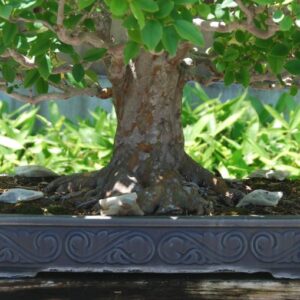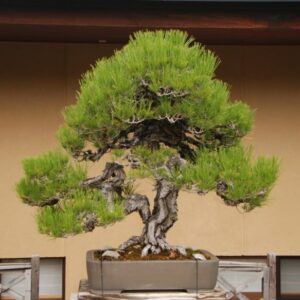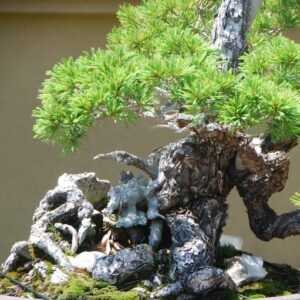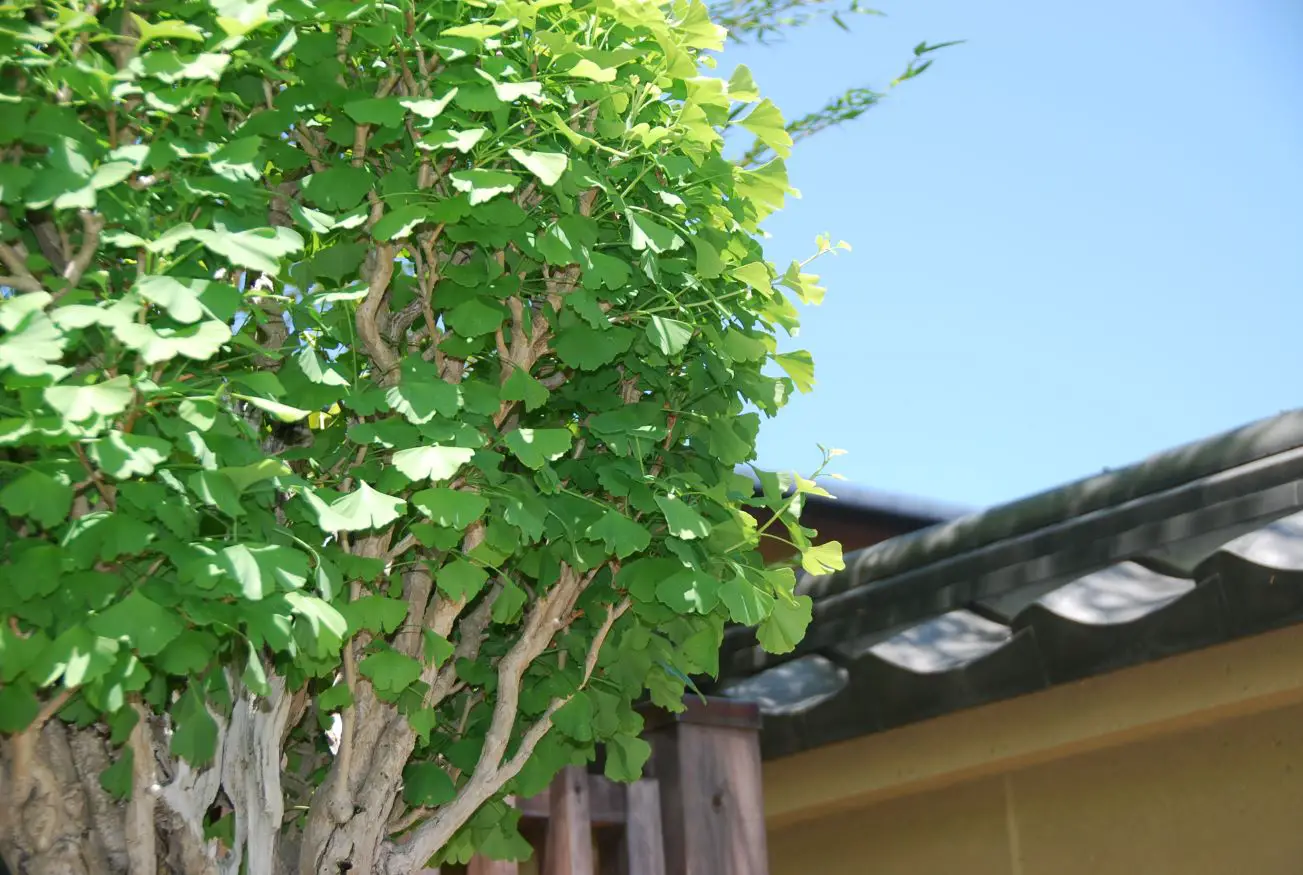Bonsai trees can get too much sun and excessive exposure to intense sunlight is harmful to them. As a general guideline, most bonsai trees thrive well outside with a balance of direct sunlight and shade.
Impact of summer sun on bonsai trees
Do bonsai need full sun in summer?

Some bonsai species need full sun all day long in summer while others prefer partial shade during the hottest hours of the day.
Japanese maple, zelkova and cherry blossom are known for their delicate foliage, which needs protection from strong summer sunlight to prevent leaf scorch. Japanese white pines, Japanese yew and other coniferous trees native to highlands or cool areas also need protection, though conifers are generally full-sun trees.
When considering the sunlight requirement for bonsai trees, it is beneficial to consider the natural habitat and the light preferences of your specific bonsai species. Those that are native to cooler regions, have a shade-loving nature, delicate foliage, and low moisture retention generally prefer partial shade in the summer.
Is too much sun bad for bonsai?

Bonsai trees can get too much sun and excessive exposure to intense sunlight can be harmful to them, though sunlight is essential for making energy through photosynthesis.
Sunburn on leaves
Just like humans, bonsai trees can experience “sunburn” if they are subjected to prolonged periods of direct, strong sunlight. Sunburn can typically manifest as yellow or discolored patches on the leaves but it can occur on stems or trunks of young trees as cracked or discolored bark.
This sunburn on tree leaves occurs from two factors:
- reactive oxygen species and
- excessive heat.
When trees are exposed to intense light, excess light energy that is not used for photosynthesis can lead to the production of reactive oxygen species. These harmful compounds can break down chlorophyll (green pigment), cause genetic changes in cells, and ultimately result in cell death, causing leaf discoloration and scorching.
Also, sudden exposure to high temperatures can weaken tree cells as they have a certain temperature limit that they can withstand. Intense light can increase leaf temperature rapidly, exceeding the threshold and resulting in leaf scorch.
It is important to note that when bonsai trees undergo gradual temperature increases, it allows them to acclimate and develop heat tolerance without experiencing sunburn.
How much sun should a bonsai get?
As a general guideline, most bonsai trees thrive well outside with a balance of direct sunlight and shade. They require several hours of direct sunlight each day to promote healthy growth and development. Morning sunlight is usually preferred especially in summer, while the harsh midday sun should be avoided or minimized.
Of course, the amount of sun each bonsai tree needs depends on various factors including its species, health, and location.
Do your bonsai trees need protection from the sun?

There are 5 factors that can provide general guidelines for summer sun protection for bonsai trees. These factors include:
- Bonsai tree species
- Geographic location
- Tree age and health
- Stress levels
- Tree size.
Bonsai tree species
There are 2 types of bonsai tree species that need protection from the summer sun:
- those with soft foliage
- trees native to highlands or cooler places
Leaves susceptible to sunburn
Japanese maple, maple, zelkova, beech, ginkgo, cherry blossom, elm, oak
Trees native to highlands or cooler places
Ezo spruce, Japanese yew, Japanese white pine, Eastern hemlock
Geographic location
The region or climate in which you live can also influence the sunlight exposure for your bonsai trees.
For example, if you live in a hot, dry and sunny area, such as Arizona, New Mexico, and parts of California and Texas where you experience long, hot summers with intense sun exposure, your bonsai trees may require protection from intense afternoon sun or prolonged exposure during heatwaves.
On the other hand, if you live in a cooler region, like NY, New Jersey, or in the Pacific Northwest, your bonsai trees may actually benefit from more direct sunlight in summer to promote healthy growth.
Tree age and health
Young bonsai trees are generally more sensitive to intense sunlight compared to mature, well-established trees because newly formed tender foliage is vulnerable to sunburn. Young trees with thin bark such as (Japanese) maple, crabapple and cherry blossom are also more susceptible to sun damage.
Similarly, trees that are weakened or in poor health may be more vulnerable to sun damage.
Stress levels
Bonsai trees that are stressed can be more susceptible to summer sun damage.
When a bonsai tree undergoes significant stress, such as repotting or wiring, its overall resilience and ability to withstand environmental factors, including intense sunlight, may be temporarily compromised. This is because their vigor is reduced and water and nutrient uptake may be negatively affected.
Mini bonsai
Mini bonsai trees are more susceptible to summer sun damage than normal size bonsai trees.
Mini bonsai trees, typically less than 8 inches (20cm) tall, live in severe conditions even as bonsai trees. Their root system is confined in such a small space that a relatively small deviation from a normal condition, such as being exposed to the summer sun, can cause serious damage.
Also, mini bonsai trees have less capacity to store water in their body compared to larger trees, besides being potted in a shallow, tiny pot. This means they can dry out more quickly when exposed to excessive heat and sunlight.
How to detect sunlight-related issues

Signs of excessive sun
If your bonsai tree is receiving excessive sunlight during the summer, it may show signs of stress or damage. Here are some signs that indicate your bonsai tree is getting too much sunlight.
- Faded or discolored leaves
- Sunburn
- Leaf loss
- Bark damage
Faded or discolored leaves
The leaves lose their vibrant color and appear faded or bleached because the strong sun (and heat) breaks down chlorophyll (green pigment) in the leaf. The discoloration may eventually become brown and brittle.
Sunburn
Leaves turn yellow or discolored patches appear on them just like sunburn on humans makes our skin discolored. This is one of the most common signs of sunburn or excessive exposure to intense sunlight.
Leaf loss
In severe cases of prolonged exposure to intense sunlight, the leaves may fall off prematurely to protect themselves from further damage.
Bark damage
The bark of especially young trees may become cracked or split on the side facing direct sunlight.
Signs of insufficient sun
Proper sunlight exposure is vital for the health and growth of bonsai trees and insufficient light can lead to a range of issues. Here are some common signs that indicate your bonsai tree may not be receiving sufficient sunlight.
- Elongated or leggy growth
- Pale or yellowing leaves
- Reduced foliage density
- Weak or stunted growth
Elongated or leggy growth
If your bonsai tree’s branches and stems appear long, weak and stretched out with widely spaced leaves in a pale or lighter color, it is likely a sign of insufficient sunlight. In an attempt to reach for more light, the trees stretch out their branches, resulting in a lanky and weak appearance.
This elongated and leggy growth may occur when excessive fertilizer is given to the bonsai trees. But in this case, the trees may appear very healthy and vigorous with darker green leaves instead of weak, pale-colored leaves.
Pale or yellowing leaves
Bonsai trees that are not receiving enough sunlight may exhibit pale or yellowing leaves. The lack of sunlight prevents the tree’s ability from producing enough chlorophyll (green pigment), leading to a decline in leaf color and vitality.
Reduced foliage density
Insufficient sunlight can result in sparse foliage of reduced density. The tree may not produce as many leaves as it should and the overall canopy may appear thin and less vibrant.
Weak or stunted growth
Bonsai trees lacking adequate sunlight may experience slow or stunted growth. The tree may struggle to develop new shoots through photosynthesis, resulting in a lack of overall vigor and vitality.
How to protect your bonsai from the summer sun

Neagari bonsai
Proper care and protection from the sun are essential to ensure the health and well-being of your bonsai tree, especially during the hot summer months. There are several effective ways to protect your bonsai from the sun.
- Provide shade
- Position strategically
- Avoid hot surfaces
- Monitor soil moisture
Provide shade
During the hottest time of the day, provide shade cloth over your bonsai trees to protect them from direct, intense sunlight.
Position strategically
Observe the sun’s movement in your garden and adjust the placement of your bonsai accordingly. Morning sunlight is usually milder and more beneficial, while the intense midday sun should be avoided. So, place them under a tree or near the house so that they get partial shade in the afternoon.
Avoid hot surfaces
Avoid placing your bonsai directly on hot surfaces such as concrete or near metal stands as they can intensify heat exposure. If you keep your trees on a balcony, you must be extra careful because its surface becomes really hot in summer.
Monitor soil moisture
Sunburns and other sun-related issues are actually exacerbated by a lack of moisture in the soil. Check the moisture level of the soil regularly and adjust your watering schedule accordingly. You may need to water your trees at least twice a day, morning and afternoon, in summer.
Avoid watering during the hottest part of the day as much as possible to prevent water droplets from acting as magnifying glasses, intensifying the sun’s rays and causing leaf burn. That said, give abundant water whenever your trees are suffering from water shortage because it may kill your tree.



